There’s a really good chance you’ll think of my advice on picking gear for telemarking as just another died in the wool leatherneck recommending old-fashioned values just because that’s the way he did it. You’d be right, except that everyone I’ve ever seen who could tele well, all of ’em, had to go through the school of hard knocks to figure out the nuances involved in making a sweet telemark turn look ridiculously easy and sexy.
In other words, don’t take my word for it, ask around and you’ll see, the hard way is the best way. Besides, let’s face some facts my friend. You’re not interested in telemarking because it’s easy; anybody who has seen it done knows it’s not easy. And while you might nod your head in agreement now, trust me, if you do take the hard road to learning how to tele you’ll know you did because you’ll question that you ever agreed with me that it could possibly be worth the amount of flailing involved to figure it out. To which I can only reply, same as ever, it is worth it.
That is, of course, trusting and assuming you persevere and figure it out. If you don’t, well, there’s always AT which stands for Already Tele’d, or Abandoned Tele for those who can’t. 😉
Learning to Tele Basics
So here’s the deal. When you’re learning to tele, in some ways, you could be better off with the crappiest gear you can find. I am not such a curmudgeon that I think you can’t learn to tele without using the gear Dicky Hall learned on, or Tom Carter and Alan Bard skied the Redline Traverse with – you don’t need to mimick the 80s to figure the tele turn out. All the same, if they could do it, it won’t hurt you to try it if only to see how hard learning to telemark can be. Even so, I don’t recommend you do this for more than a quick lesson in humility so you stop whining about how difficult the tele turn is to learn even with plastic teleboots and a G3 Targa, which, believe me, is a huge improvement over 3-pin bindings, leather lace up boots and 60mm wide, 205cm double-cambered skis. Even with such “advanced” gear it will take some time to learn how to weight and drive your rear ski, but you can and if you’ve read thus far, I trust you will.Boots
When looking for boots I recommend old, broken down plastic tele boots because they are the closest thing to leather boots in their prime without actually being leather; they’re soft enough to allow you to feel lots of pressure on the ball of your trailing foot so you can learn how to balance on it reliably, and stiff enough laterally to be able to drive a modern mid-fat or narrow ski, either of which is at least 20% wider than skis were back in the day. They’re also cheaper when used and the idea here isn’t to buy something that will last you a long time, just long enough for you to learn the turn.It bears mentioning that even if you get a steal of a deal on a used pair, don’t scrimp on making sure the boots fit you well. If you need to, spend a few Franklin’s to get the boots properly fitted. That may seem like a lot, but it is a universal observation that you will feel better and ski better if your boots fit better. This is even more critical with telemark boots since you will be flexing them, so they need to feel comfortable standing up, or squatting low, and all points in between.
Here’s another thing you need to know about telemark. It isn’t all about the turn. Part of the appeal is the simple pleasure of wearing a boot that is comfortable in a way that a rigid-soled alpine boot never ever can be. So make sure to you take advantage of the walking comfort factor and get your boots fitted to your feet.
Duckbill or Duckbutt?
Although there are two different norms, you’re more likely to find a pair of 75mm boots with a duckbill, also known as the Nordic Norm. These boots are arguably superior for learning than the New Telemark Norm which is characterized by a boot with a bellows for flexing, but without the protruding duckbill. Instead, these boots have an alpine shape at the toe, making them compatible with plate style AT bindings, and for the purpose of telemarking, a second heel — a small shelf attached to the sole behind the bellows, around the middle of the boot, that an NTN binding uses to hook onto the boot.
I don’t want to dissuade you from buying an NTN boot and binding combination, but you will end up missing out on some of the humility available when learning to telemark. This may be a good thing, but as I indicated earlier, those moments of being schooled with and by poor technique, in part due to inferior equipment, impart a deeper sense of balance that needs to become second nature for telemark to be pleasureable. Thus, you can shortcut some things with superior gear, but developing deep roots in tele demands the trials and tribulations of floundering on the floor of shame. And trust me on this, if you don’t have deep roots in tele you’re just postponing the inevitable switch to the dark side of free heel freedom where you exchange a free mind and free heels for lighter weight 2-pin tech gear and the mental security of acceptance by the herd.
Bindings
There is another reason why you want to go with a classic duckbilled system. Not only are there potentially more boots to chose from, there are a ton of bindings to chose from. Again, it doesn’t matter too much which one you get, the purpose is to get something that will allow you to telemark.For plastic telemark boots, be sure to get a cable binding. Cable bindings use spring tension applied to the heel of your boot which creates a force to balance against when weighting your rear ski. Cable bindings from the 90s such as G3’s Targa, Rottefella’s Cobra, or Voile’s Hardwire would all be good models to consider. You could also be a pin-headed Puritan and get a pair of 3-pin bindings, but those were intended for use with leather boots. Unless you’re going full retro, wool knickers included, stick to plastic and cables.
If you can, find an old pair of Hammerhead bindings. These were the first telemark binding to provide adjustability to how active a binding was that was obvious and easy to implement. The modern equivalent is 22D’s Vice, but it doesn’t have the same range of adjustment as the Hammerhead. HH had five positions. The majority of users preferred the middle position, #3, or one position further aft, #4. However, while positions #1 and #2 were not very popular, these less active positions are excellent teaching tools for learning how to flex a boot and balance while using less spring tension to tele. It does make telemarking more difficult, but learning how to overcome this is part of how you learn the turn better. For your formative runs no one will hold it against you to take advantage of the activeness of position #5 to wean yourself from a fully locked heel to a free one. As you get more comfortable, dial the tension level down. At some point you’ll probably settle on position #3 or #4.Backcountry Bindings
If you know you’re going to want to go in the backcountry, then you should seriously consider getting a telemark touring binding with the ability to switch from a free heel with resistance for turning, to a free pivoting toe with zero resistance for earning your turns. In that case, there are still plenty to chose from on the used market, but three deserve putting at the top of your list.
If you aren’t sure about how active you want your tele binding to be, or you know you want a powerful binding ‘cuz you’re an aggressive skier, get 22 Design’s Axl, with three cable pivot positions equivalent to HH#3 thru HH#5. If weight matters and you don’t need an overly active binding, Voile’s Switchback or Switchback X2 are great choices. They weigh less than 1.5 pounds per foot and are the binding least likely to ice up. In the right (er, wrong?) conditions any binding can ice up, but Switchback is more immune than many tech bindings are, let alone any other telemark binding.The third would be Black Diamond’s O1. This was the first free-pivoting telemark binding that had downhill power on par with HH#3. Some might argue it was less, but those would be the grey-haired tele nerds splitting hairs on binding activity levels; a colossal waste of time. It’s a solid binding with a mode switch to flip between a free pivot and a locked toe just by pressing down with a ski pole.
Of course all these bindings have limits and quirks — and if you want the eensty weentsy details there are plenty of reviews of each on this site — but none of those issues are deal breakers, just part of each products “personality.”Skis
If you’re learning then you want to make sure you have an older pair of skinny skis, but no need to go narrower than 80mm at the waist, 76mm if you chance upon a pair of Mountain Noodles, the original fat backcountry ski. Dull edges will make you work harder to hold an edge, but you won’t be ridiculed for getting them tuned and sharpened either.
If you are going semi-new with your gear and getting a tele binding with a free-pivot tour mode, then you might as well get a new pair of skis, or least some that are approximately 90mm at the waist. This is wide enough to give decent flotation in soft snow, but not so wide that you’ll have a hard time holding an edge with a free heel. Well, not any harder than it already is. Until you actually know how to really weight the rear ski in a tele turn, getting skis fatter than 100mm at the waist will hinder your development. Besides, one of the reasons you should be telemarking is because you prefer deep snow. With tele, it’s always knee deep, and it’s easier to make it even deeper by keeping the width of your skis to less than 100mm at the waist. And yes, of course that makes it harder to tele. Tele isn’t about easy, so stop whining about how hard it is and repeat after me, a hard turn is good to find.
© 2015
Related Posts
Telemark Binding Selection Guide
Boot Fitting Tips
Telemark Boot Reviews

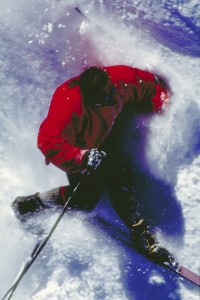
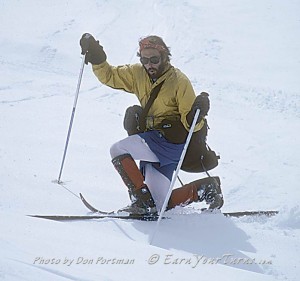
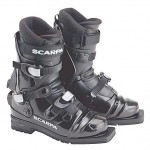
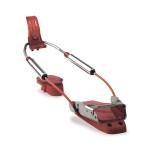


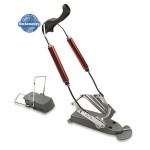
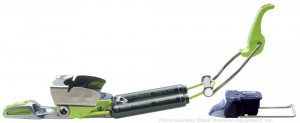
12 pings
Skip to comment form